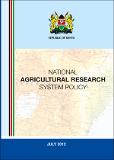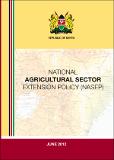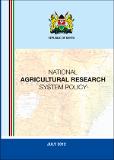Working Paper No. 23 of 2017 on an Assessment of Rwanda's Agricultural Production, Climate Change, Agricultural Trade and Food Security
Publication Date
2017Author
Type
KIPPRA Publicationsviews
downloads
Metadata
Show full item recordBy
Gasheja, Faustin & Gatemberezi, Paul
Abstract/
Rwanda is a small, hilly, landlocked country located in Eastern and Central Africa region between Burundi, Uganda, Tanzania and the Democratic Republic of Congo (DRC). It is located 2° south of the Equator in Central Africa and covers a surface area of 26,338 square kilometers. Due to high altitude, the country experiences average annual temperatures ranging from 16° to 20°C. The climate is moderate and characterized by temperate conditions, especially in higher altitudes in the Northwest of the country. The topography is hilly to mountainous with altitude ranging from 950 to 2,500 meters above sea level. Rwanda has the highest population density in Africa. Moreover, the country is characterized by agro-ecological diversity, with 12 agro-ecological zones. The objective of this study is to assess the spatial effects of climate change on agricultural production, and food security in the East African Community region, especially in Rwanda. Agriculture is the backbone of Rwanda’s economy. It contributes 34 per cent of Gross Domestic Product (GDP). About 81 per cent of all households depend on agriculture, which employs around 70 per cent of the Rwandan population that lives in rural areas. Agricultural production is predominantly at a subsistence level because a large number of rural household’s farm plots are too small to support commercial production. The Government of Rwanda adopted the Crop Intensification Programme (CIP) in 2008 with a goal to increase agricultural productivity of high potential food crops and to provide Rwanda with greater food security. The implementation of this programme involves various components, including Land Use Consolidation (LUC ) as the main pillar, proximity advisory services to farmers, inputs (seeds and fertilizers) distribution, improving post-harvest technologies (e.g. driers and storage facilities) and access to extension services. The priority food crops in the programme include Irish potatoes, maize, wheat, rice, cassava, soybean and beans.
Subject/
Climate Change; Agricultural Production; Food Security; Agricultural Trade; Rwanda-Africa
Publisher
The Kenya Institute for Public Policy Research and Analysis (KIPPRA)Series
WP/23/2017;Collections
- Working Papers [34]
Related items
Showing items related by title, author, creator and subject.
-
National Agricultural Research System Policy 2012
Agricultural Sector Coordination Unit (ASCU) (Ministry of Agriculture, 2012)The policy objectives are: improving agricultural research policy framework; harmonizing and providing direction to national research for sustainable development; strengthening the legal, institutional and regulatory ... -
Sessional Paper No. 04 of 2011 on National Agricultural Sector Extension Policy (NASEP)
Ministry of Agriculture, Livestock & Fisheries (Ministry of Agriculture, Livestock & Fisheries, 2011)The agricultural sector provides a livelihood for about 80 percent of Kenya's population, most of whom are subsistence farmers in rural areas. The sector contributes about 24 per cent to the GDP and another 27 per cent ... -
Kenya Youth Agribusiness Strategy 2017-2021: Positioning the youth at the forefront of Agricultural Growth and Transformation
Ministry of Agriculture, Livestock & Fisheries (Ministry of Agriculture, Livestock & Fisheries, 2017)Youth account for 35.4% of Kenya’s population (World Bank 2014), with 1,000,000 entering the labour market annually (Kenya Country Report on Youth Employment, 2014). They offer a dynamic work force that is innovative; have ...




